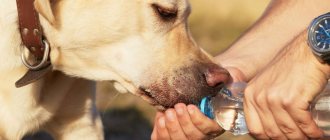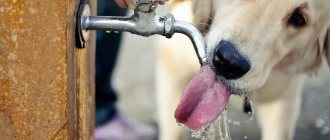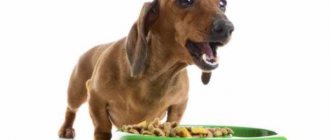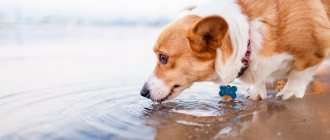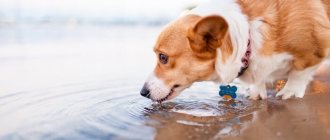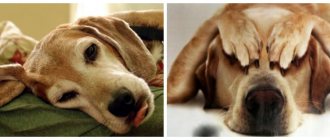Just like people, dogs need to drink enough water every day to stay hydrated. Thanks to this, they will be able to maintain their physiological functions at an optimal level. Factors such as illness may cause your dog to drink less water than usual or stop drinking it altogether. Some dogs may eat well while others lose their appetite. Here we discuss common reasons why a dog won't drink water and the corrective measures you can take to encourage your dog to drink water.
The role of water in the dog's body
The dog does not drink water.
There is no particular need to explain why the dog needs water. Liquid is much more important for the body of a living creature than food. Even slight dehydration can lead to unpleasant consequences. Water is necessary for the functioning of the circulatory and digestive systems. The liquid also helps remove toxins from the body.
The amount of fluid consumed (norm) depends on the age, weight of the animal, and the weather. For example, in hot weather a dog should drink much more than if it is cool outside.
Important! If the dog lives in his own house, you should pay attention to whether he eats snow in winter. This method helps quench thirst, but is not useful.
What kind of water can you give your dog?
In order for the pet to be healthy and cheerful, when it comes to drinking, owners must follow the following rules:
- The liquid must always be clean. Dirt quickly collects and accumulates in open containers, so a person must clean and change the water in the drinking bowl.
- The fluid should be changed at least 2 times a day.
- The liquid should be at room temperature.
- The animal should always have access to clean water. Especially if your pet’s diet consists of dry food.
The water must be clean
Warning signs
When organizing a balanced diet for an animal, 24-hour access to water is a prerequisite. The water should be changed daily. It’s good if the owner, when changing the water, notices a decrease in the level relative to the original amount.
But, as a rule, water replacement is carried out mechanically and deviations in the pet’s condition are already noticed by the changed behavior.
The main signs that may indirectly indicate a pet is dehydrated include the following:
- loss of appetite;
- loss of interest in life, lethargy, apathy;
- dull look;
- sunken eyes;
- red eyes.
What kind of water should you not give to your dog?
First of all, you should remember that you should not give your animal dirty water, and this also applies to technical fluid, even if it has been purified. Water should not contain harmful elements or chemicals.
In addition, it is forbidden to give your pet rainwater from a puddle or drain. Do not forget that in this case a large number of harmful microbes penetrate into the dog’s body.
Important! If your pet begins to show interest in liquid from the toilet, this should also be stopped.
Drinking regimen in case of poisoning
If the dog has been poisoned by low-quality products, and you are sure that these are not alkalis, acids or other dangerous chemicals, then when vomiting it is important to restore the water balance so that dehydration does not occur. Feed the animal in small portions; you can gradually pour water into the mouth.
If it is necessary to rinse the stomach, then the pet is forcibly given a large amount of clean warm water. But in case of any poisoning, you must urgently contact a veterinarian; he will give more detailed and accurate advice depending on your case.
Remember! If a dog is poisoned by alkalis or acids, vomiting should not be caused. These substances further injure the digestive tract.
Don’t forget that water is the most important part of any animal’s diet, so don’t be lazy to change the water and keep it clean if you don’t want to harm your pet.
On our website there are more than 3410 veterinary clinics in Moscow for you on our website
How much should a dog drink per day?
As already mentioned, the amount of fluid consumed directly depends on the weight of the pet. In addition, the age of the dog also matters. The indicators will be as follows:
- For puppies, there is at least 100 ml per 1 kilogram of weight. water.
- For an adult dog 1 kg. weight norm is 50 ml.
There is another way to calculate the minimum and maximum values. To start, you will also need the weight of the animal, for example 25 kg. To get the minimum value, the weight is multiplied by 20 (20*25=500), to get the maximum value, the weight is multiplied by 70 (70*25=1750).
The average is calculated using the following formula: max. + min./2.. (500+1750)/2 = 1125 ml. This is exactly how much a dog should consume per day.
Important! It must be remembered that in the summer, during the heat, the body needs more fluid. It is best to change the water 3 times a day during such periods.
The animal needs a certain amount of fluid per day
Daily fluid volume for a dog
For the natural course of all processes in a dog’s body, there is a minimum and maximum daily fluid intake for the animal.
Knowing the dog’s weight, you can determine its daily fluid requirement:
- the minimum requirement is the dog's weight multiplied by 20 milligrams;
- the maximum requirement is the dog's weight multiplied by 70 milligrams.
Your pet's consumption of liquid food (soups, broths, cereals, etc.) is counted as liquid intake.
Signs of exhaustion and illness
If a dog refuses water, sooner or later this will lead to obvious signs of dehydration and exhaustion. You can check the condition of the animal in several ways:
- Pull the skin at the withers and then release. In normal condition, the fur and skin quickly return to their original place. A slow reaction indicates a lack of fluid.
- Check the condition of your gums. If everything is normal, they have a reddish-pink tint. When pressed, the gums turn white, but then quickly return to their normal color.
In addition, dehydration is accompanied by other symptoms:
- refusal to eat;
- lethargy, drowsiness;
- dull look, the iris becomes faded;
- redness of the whites;
- the dog stops being active and lies down more;
- The dog begins to urinate less often and does it with difficulty.
Oral diseases
Damage to the mouth may include periodontal disease, tooth root abscess, luxated or fractured jaw, loss of sensation, or cancer. Periodontal disease is a bacterial infection of the mouth that is very common. Periodontal disease and tooth root abscess are typically associated with poor oral hygiene, while tooth root abscess, luxation, loss, or fracture occur due to dental trauma. Oral cancer is the abnormal growth of a tumor in the mouth. Cancer can occur in dogs of any age, but is more common in older dogs.
Reasons why a dog doesn't drink water
Why doesn't the dog drink water? The reasons may be different:
- Dirty dishes are on display or the liquid in the bowl is dirty. As already mentioned, the animal’s dishes should also be cleaned regularly (at least 1-2 times a day). Otherwise, dirt and drool will quickly accumulate in the bowl and the water itself.
- There is damage in the oral cavity. This could be the tongue, the gums themselves, or the teeth. In any case, it will simply be painful for your pet to drink.
- Diseases of the respiratory system. A cold or laryngitis causes swelling in the throat and makes swallowing painful.
- The dog is pregnant. At certain times, refusal of liquid will be normal.
- The animal has not yet recovered from castration or sterilization.
- Diseases. Ailments can be very different, including cancer, problems with the genitourinary system, poisoning, and so on.
Important! If you are not sure why your dog is not drinking water, it is best to take the dog to the veterinarian. You should not put off going to the doctor; early diagnosis will help prevent unpleasant consequences.
Refusal to drink water can happen for a variety of reasons.
Nausea
There are some medical conditions that can cause nausea in dogs, and nausea can cause your dog to drink less.
Kidney disease often causes increased thirst in the early stages. However, as the disease progresses and kidney enzyme levels rise, dogs often begin to vomit. This nausea can lead to decreased appetite, decreased thirst, and possibly even vomiting.
Conditions that cause inflammation of the gastrointestinal tract, such as pancreatitis and gastroenteritis, can also cause nausea.
If you notice changes in your dog's thirst that are also accompanied by decreased appetite, vomiting, or diarrhea, have your dog examined by a veterinarian as soon as possible to determine and treat the underlying cause.
If your puppy doesn't drink water
Why does my puppy drink little water? This question also worries pet owners. It all depends on the situation: if the dog continues to eat well, then there is most likely nothing to worry about. Most likely, the baby gets enough fluid from food (if the food is natural and not store-bought).
In addition, the puppy may not yet know how to lap. You cannot teach this on your own. In some cases, the dog has to be bottled.
However, there may be other, less harmless reasons:
- poisoning;
- entry of a foreign object into the body;
- disruption of internal organs;
- intestinal obstruction and so on.
On the road
On the road, it is not always possible to find suitable water for your pet, and it is impossible to leave him without it. Drinking from your hands is a bad idea; almost all the water will spill on the ground. For such cases, a simple invention was invented - a road drinker.
They are usually made of lightweight plastic and are cheap and practical. The plastic bottle can be replaced, the cap is of standard sizes, there are also caps with dispensers - this will make it more convenient to use, and the dog will not spill anything. Drinking bowls are sold at pet stores.
Consequences of not drinking
In general, a lack of fluid quickly has a negative effect on the body. The consequences may be as follows:
- lethargy, lethargy;
- decreased tone;
- joint problems;
- disruption of internal organs;
- deterioration of metabolism;
- poisoning by toxins that are no longer excreted;
- development of chronic diseases.
Important! If you delay in solving the problem, your pet’s condition will only worsen. As a result, surgery may be required or the animal will simply die.
Dehydration and exhaustion
Dehydration
If your pet is panting or drooling more than usual, has red, dry or sticky gums, a fever, heat, trouble with normal coordination, or skin that doesn't retain its normal moisture and elasticity, your dog may be suffering from dehydration.
Strangely, the more dehydrated a dog is, the less interested he is in water.
Dehydration can be a sign of pancreatitis, which is inflammation of the pancreas. Pancreatitis can be caused by fatty or irregular feeding, obesity or diabetes.
How to train a dog to drink water
It is simply impossible to force a dog to drink water. The owner can only create the most suitable conditions so that the dog himself wants to drink. Some tips:
- Walk more with your pet and do active physical exercise.
- Provide food according to a specific schedule.
- Clean drinking water should always be available to the animal.
- It is best to try not to scold or irritate your pet again. Stress also negatively affects pets.
What not to do
You should never use force against an animal. If you force him to drink, there will still be no result, and the pet will experience even more stress. It is better to use tricks such as changing the bowl or adding luda cubes to the water. The dog loves to drink cool liquids, so this method may attract him.
You should not let your pet eat snow or drink from a puddle while walking. Always have a portable drinking bowl with you. It is strictly forbidden to scold a dog, since it stops drinking not of its own free will, but due to disturbances in its physical or mental state.
Compliance with the drinking regime and proper care of your pet will avoid problems with dehydration and the development of complications associated with it.
Water for a decorative dog
The physical condition of toy dogs is more fragile than that of large dogs. As for drinking them, the owner should remember the following additional rules:
- Puppies need to be given water every 2 hours. They should drink in small portions.
- If the dog drains the bowl immediately after active play, you should not pour new liquid at the same minute. You need to wait a little.
- For a long walk, be sure to take a water bottle.
- Particular attention should be paid to the amount of fluid you drink during hot periods.
The issue of drinking water for pets is very important. The owner must monitor the quantity and quality of the liquid, because the condition and physical strength of the four-legged friend depend on this.
